Post-COVID 19 Tourism: Will Digital Tourism Replace Mass Tourism?
Abstract
1. Introduction
2. Materials and Methods
3. Results
3.1. Descriptive Analysis
3.2. Classifications of Literature
3.3. Digital Tourism
3.4. Virtual Reality
3.5. Augmented Reality and Social Media Tourism
3.6. Collaborative Work on Digital Tourism
4. Conclusions
Future Agenda and Limitations
Author Contributions
Funding
Institutional Review Board Statement
Informed Consent Statement
Data Availability Statement
Acknowledgments
Conflicts of Interest
References
- Beine, M.; Bertoli, S.; Chen, S.; Ambrosio, C.D.; Islam, N.; Koulovatianos, C.; Leduc, K.; Lorenz, N.; Peluso, E.; Peroni, C.; et al. Economic Effects of Covid-19 in Luxembourg First RECOVid Working Note with Preliminary Estimates; Research Luxembourg: Luxembourg, 2020. [Google Scholar]
- Kayumovich, K.O. Prospects of Digital Tourism Development. Economics 2020, 23–24. [Google Scholar] [CrossRef]
- Yeung, K.; Galindo, D. Why Do Public Blockchains Need Formal and Effective Internal Governance Mechanisms? SSRN Electron. J. 2019. [Google Scholar] [CrossRef]
- Gössling, S.; Scott, D.; Hall, C.M. Pandemics, tourism and global change: A rapid assessment of COVID-19. J. Sustain. Tour. 2020, 29, 1–20. [Google Scholar] [CrossRef]
- Jones, P.; Comfort, D. The COVID-19 Crisis, Tourism and Sustainable Development. Athens J. Tour. 2020, 7, 75–86. [Google Scholar] [CrossRef]
- Oztemel, E.; Gursev, S. Literature review of Industry 4.0 and related technologies. J. Intell. Manuf. 2020, 31, 127–182. [Google Scholar] [CrossRef]
- Sarkar, S.K.; Toanoglou, M.; George, B. The Making of Data-Driven Sustainable Smart City Communities in Holiday Destinations. In Digital Transformation in Business and Society; Metzler, J.B., Ed.; Palgrave Macmillan: Cham, Switzerland, 2020; pp. 273–296. [Google Scholar]
- Ranasinghe, R.; Karunarathna, C.; Pradeepamali, J. After Corona (COVID-19) Impacts on Global Poverty and Recovery of Tourism Based Service Economies: An Appraisal. SSRN Electron. J. 2020. [Google Scholar] [CrossRef]
- De Luca, G.; Dastgerdi, A.S.; Francini, C.; Liberatore, G. Sustainable Cultural Heritage Planning and Management of Overtourism in Art Cities: Lessons from Atlas World Heritage. Sustainability 2020, 12, 3929. [Google Scholar] [CrossRef]
- Fauziah, C.L. The Geography of Accessibility: Assessing the Malaysian Approach to COVID-19 Pandemic Management. GEOGRAFI 2020, 8, 66–91. [Google Scholar]
- Nurgalieva, G. The Islamic Economy—The Fastest Growing Large Economy. Eurasian Focus. SSRN Electron. J. 2018. [Google Scholar] [CrossRef]
- Dencker, M. Software Is Feeding the World Develop Your Organisation to Sustain; Wiredelta: Copenhagen, Danmark, 2019. [Google Scholar]
- Moher, D.; Liberati, A.; Tetzlaff, J.; Altman, D.G.; Antes, G.; Atkins, D.; Barbour, V.; Barrowman, N.; Berlin, J.A.; Clark, J.; et al. Preferred reporting items for systematic reviews and meta-analyses: The PRISMA statement. PLoS Med. 2009, 6. [Google Scholar] [CrossRef]
- Rodríguez-López, N.; Diéguez-Castrillón, M.I.; Gueimonde-Canto, A. Sustainability, and tourism competitiveness in protected areas: State of art and future lines of research. Sustainability 2019, 11, 6296. [Google Scholar] [CrossRef]
- Qureshi, M.; Khan, N.; Qayyum, S.; Malik, S.; Sanil, H.; Ramayah, T. Classifications of Sustainable Manufacturing Practices in ASEAN Region: A Systematic Review and Bibliometric Analysis of the Past Decade of Research. Sustainability 2020, 12, 8950. [Google Scholar] [CrossRef]
- Lin, L.-P.; Huang, S.-C.; Ho, Y.-C. Could virtual reality effectively market slow travel in a heritage destination? Tour. Manag. 2020, 78, 104027. [Google Scholar] [CrossRef]
- Lixing, Z. Impact of the COVID-19 Outbreak on the World and the Inspirations. Glob. J. Manag. Bus. Res. 2020, 29–37. [Google Scholar] [CrossRef]
- Bogicevic, V.; Seo, S.; Kandampully, J.A.; Liu, S.Q.; Rudd, N.A. Virtual reality presence as a preamble of tourism experience: The role of mental imagery. Tour. Manag. 2019, 74, 55–64. [Google Scholar] [CrossRef]
- Tussyadiah, I.P.; Wang, D.; Jung, T.H.; Tom Dieck, M.C. Virtual reality, presence, and attitude change: Empirical evidence from tourism. Tour. Manag. 2018, 66, 140–154. [Google Scholar] [CrossRef]
- Rejón-Guardia, F.; García-Sastre, M.A.; Orfila-Sintes, F.; Garau-Vadell, J.B. Virtual reality in tourism: Centennials acceptance. Tour. Anal. 2020, 25, 335–344. [Google Scholar] [CrossRef]
- Errichiello, L.; Micera, R.; Atzeni, M.; Del Chiappa, G. Exploring the implications of wearable virtual reality technology for museum visitors’ experience: A cluster analysis. Int. J. Tour. Res. 2019, 21, 590–605. [Google Scholar] [CrossRef]
- Kim, M.J.; Hall, C.M. A hedonic motivation model in virtual reality tourism: Comparing visitors and non-visitors. Int. J. Inf. Manag. 2019, 46, 236–249. [Google Scholar] [CrossRef]
- Han, D.-I.D.; Dieck, M.C.T. Calling for user-centric VR design research in hospitality and tourism. Hosp. Soc. 2019, 9, 237–246. [Google Scholar] [CrossRef]
- Jude, O.C.; Ukekwe, C. Tourism and virtual reality (VR) in developing nations. Afr. J. Hosp. Tour. Leis. 2020, 9, 1–16. [Google Scholar]
- Flavián, C.; Ibáñez-Sánchez, S.; Orús, C. Integrating virtual reality devices into the body: Effects of technological embodiment on customer engagement and behavioral intentions toward the destination. J. Travel Tour. Mark. 2019, 36, 847–863. [Google Scholar] [CrossRef]
- Moorhouse, N. Virtual reality as an urban tourism destination marketing tool. Int. J. Technol. Mark. 2019, 13, 285. [Google Scholar] [CrossRef]
- Wreford, O.; Williams, N.L.; Ferdinand, N. Together Alone: An Exploration of the Virtual Event Experience. Event Manag. 2019, 23, 721–732. [Google Scholar] [CrossRef]
- Louw, C.; Louw, B.L. The digital disruption of virtual reality and the future of the steel roller coaster: An initial industry analysis. Afr. J. Hosp. Tour. Leis. 2018, 7, 1–16. [Google Scholar]
- Orru, K.; Kask, S.; Nordlund, A. Satisfaction with virtual nature tour: The roles of the need for emotional arousal and pro-ecological motivations. J. Ecotour. 2018, 18, 221–242. [Google Scholar] [CrossRef]
- Marasco, A.; Balbi, B. Designing accessible experiences for heritage visitors through virtual reality. E-Rev. Tour. Res. 2019, 17, 426–443. [Google Scholar]
- Shatnawi, T.; Ashour, L.; Kakeesh, D. Investigating the impact of atmospherics and online flow cues on visiting intentions: The case of Jordan’ virtual tourist centre. Int. J. Electron. Mark. Retail. 2020, 11, 1–23. [Google Scholar] [CrossRef]
- Schott, C.; Marshall, S. Virtual reality and situated experiential education: A conceptualization and exploratory trial. J. Comput. Assist. Learn. 2018, 34, 843–852. [Google Scholar] [CrossRef]
- Buhalis, D.; Harwood, T.; Bogicevic, V.; Viglia, G.; Beldona, S.; Hofacker, C. Technological disruptions in services: Lessons from tourism and hospitality. J. Serv. Manag. 2019, 30, 484–506. [Google Scholar] [CrossRef]
- Han, D.-I.; Jung, T.; Gibson, A. Dublin AR: Implementing Augmented Reality in Tourism. In Information and Communication Technologies in Tourism 2014; Metzler, J.B., Ed.; Springer: Cham, Switzerland, 2013; pp. 511–523. [Google Scholar]
- Keckes, A.; Tomicic, I. Augmented Reality in Tourism—Research and Applications Overview. Interdiscip. Descr. Complex Syst. 2017, 15, 157–167. [Google Scholar] [CrossRef]
- Barrado-Timón, D.A.; Hidalgo-Giralt, C. The Historic City, Its Transmission and Perception via Augmented Reality and Virtual Reality and the Use of the Past as a Resource for the Present: A New Era for Urban Cultural Heritage and Tourism? Sustainability 2019, 11, 2835. [Google Scholar] [CrossRef]
- He, Z.; Wu, L.; Li, X. When art meets tech: The role of augmented reality in enhancing museum experiences and purchase intentions. Tour. Manag. 2018, 68, 127–139. [Google Scholar] [CrossRef]
- Gibson, A.; O’Rawe, M. Virtual Reality as a Travel Promotional Tool: Insights from a Consumer Travel Fair. In Augmented Reality and Virtual Reality; Metzler, J.B., Ed.; Springer: Cham, Switzerland, 2018; pp. 93–107. [Google Scholar]
- Coghlan, A.; Carter, L. Serious games as interpretive tools in complex natural tourist attractions. J. Hosp. Tour. Manag. 2020, 42, 258–265. [Google Scholar] [CrossRef]
- Muñoz-Leiva, F.; Hernández-Méndez, J.; Gómez-Carmona, D. Measuring advertising effectiveness in Travel 2.0 websites through eye-tracking technology. Physiol. Behav. 2019, 200, 83–95. [Google Scholar] [CrossRef] [PubMed]
- Azarova, O.A.; Goryacheva, E.N.; Ilkevich, S.V.; Sevryukova, O.I.; Stakhova, L.V. Development of cross-cultural communication in international tourism. J. Environ. Manag. Tour. 2019, 10, 1376–1381. [Google Scholar] [CrossRef]
- Flavián, C.; Ibáñez-Sánchez, S.; Orús, C. The impact of virtual, augmented and mixed reality technologies on the customer experience. J. Bus. Res. 2019, 100, 547–560. [Google Scholar] [CrossRef]
- Peukert, C.; Pfeiffer, J.; Meißner, M.; Pfeiffer, T.; Weinhardt, C. Shopping in Virtual Reality Stores: The Influence of Immersion on System Adoption. J. Manag. Inf. Syst. 2019, 36, 755–788. [Google Scholar] [CrossRef]
- Roma, P.; Aloini, D. How does brand-related user-generated content differ across social media? Evidence reloaded. J. Bus. Res. 2019, 96, 322–339. [Google Scholar] [CrossRef]
- Khan, N.; Qureshi, M.I. A Systematic Literature Review on Online Medical Services in Malaysia. Int. J. Online Biomed. Eng. (iJOE) 2020, 16, 107–118. [Google Scholar] [CrossRef]
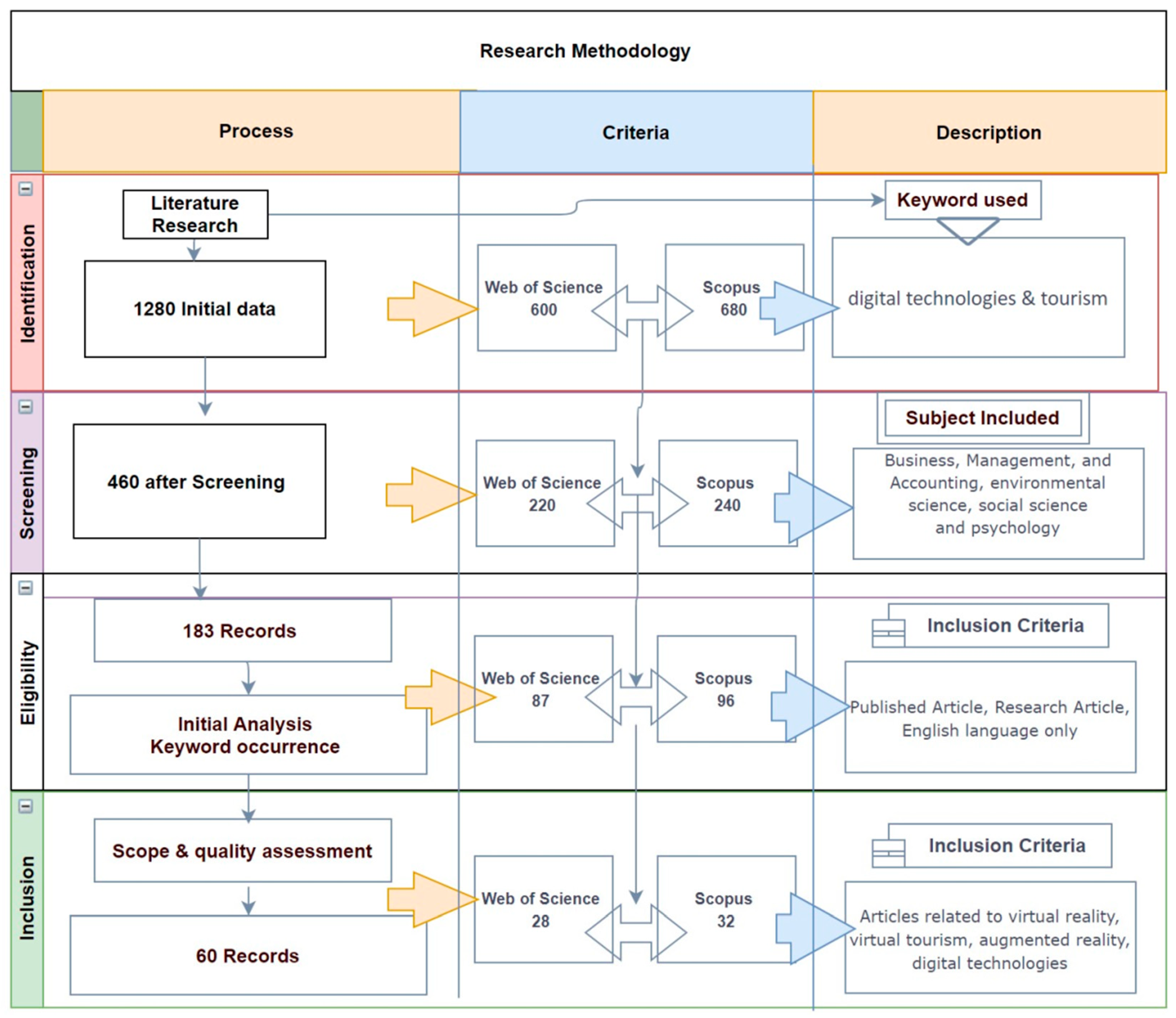
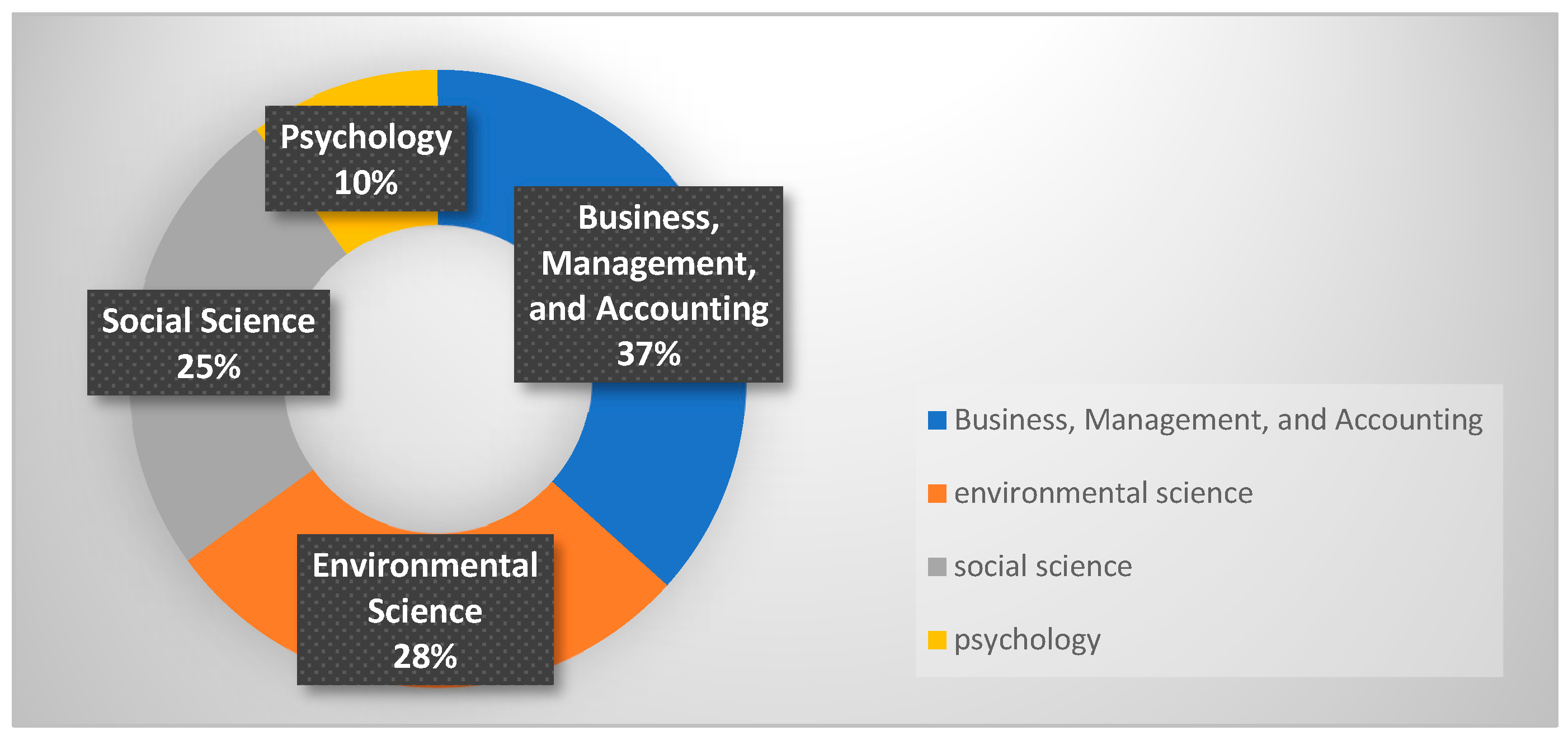
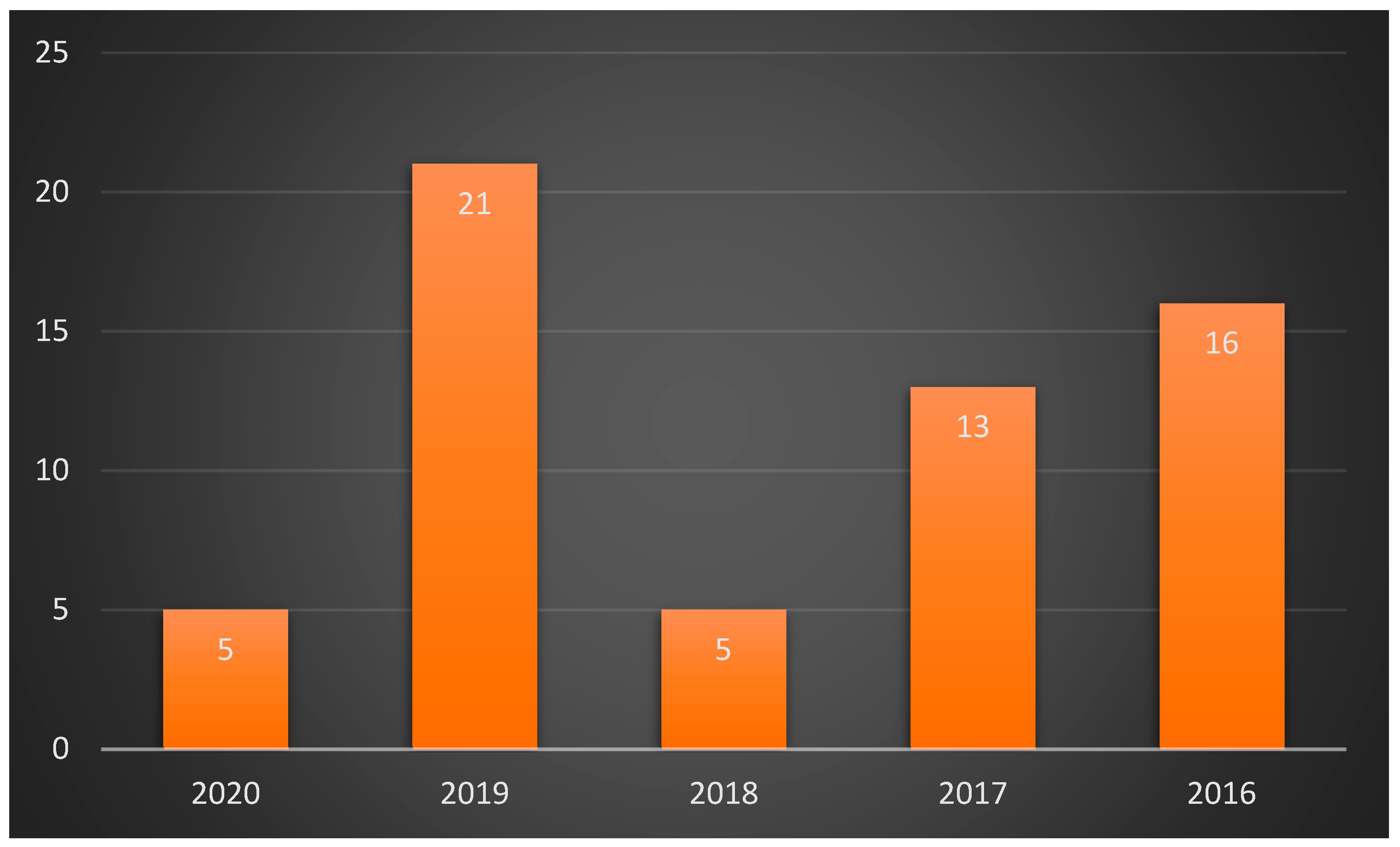
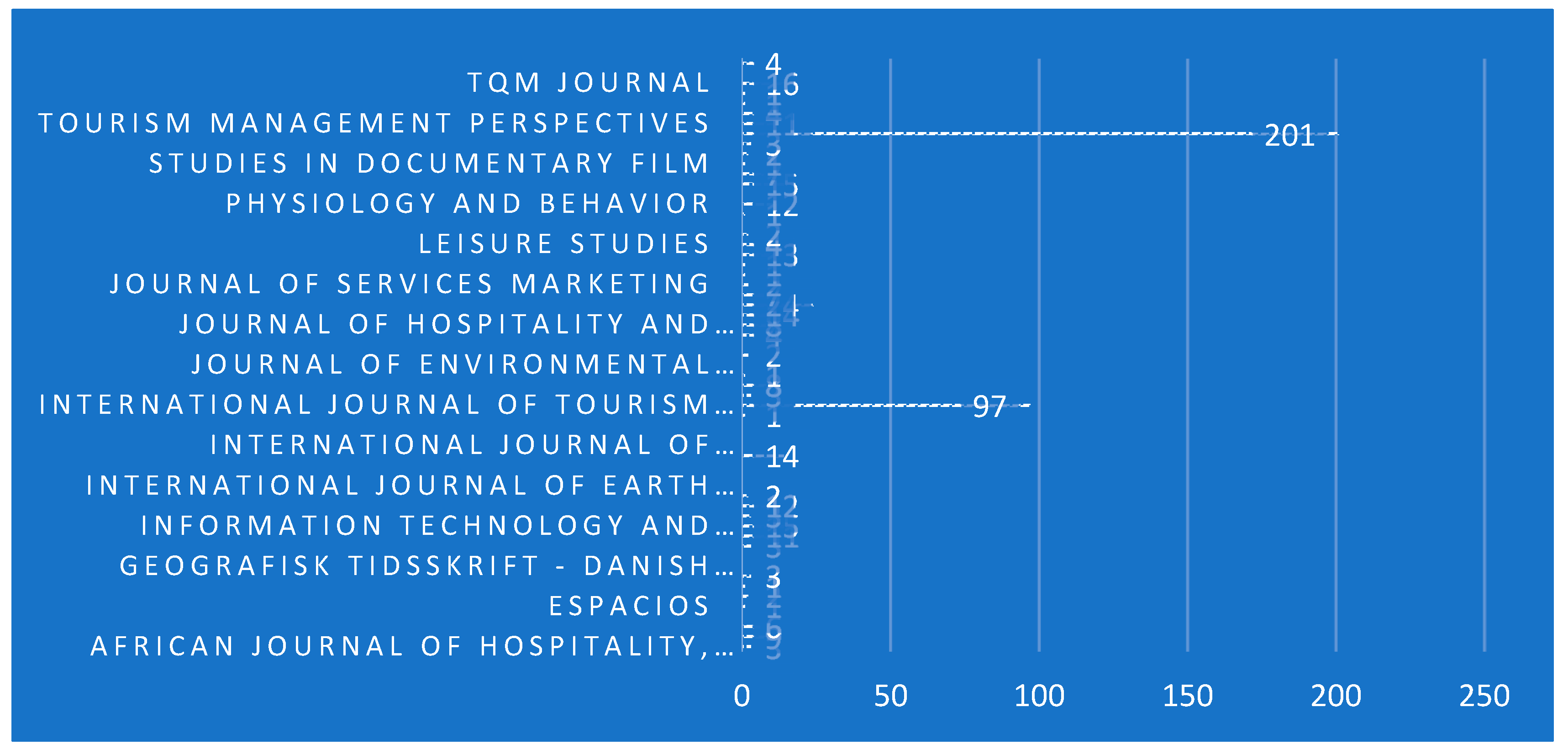
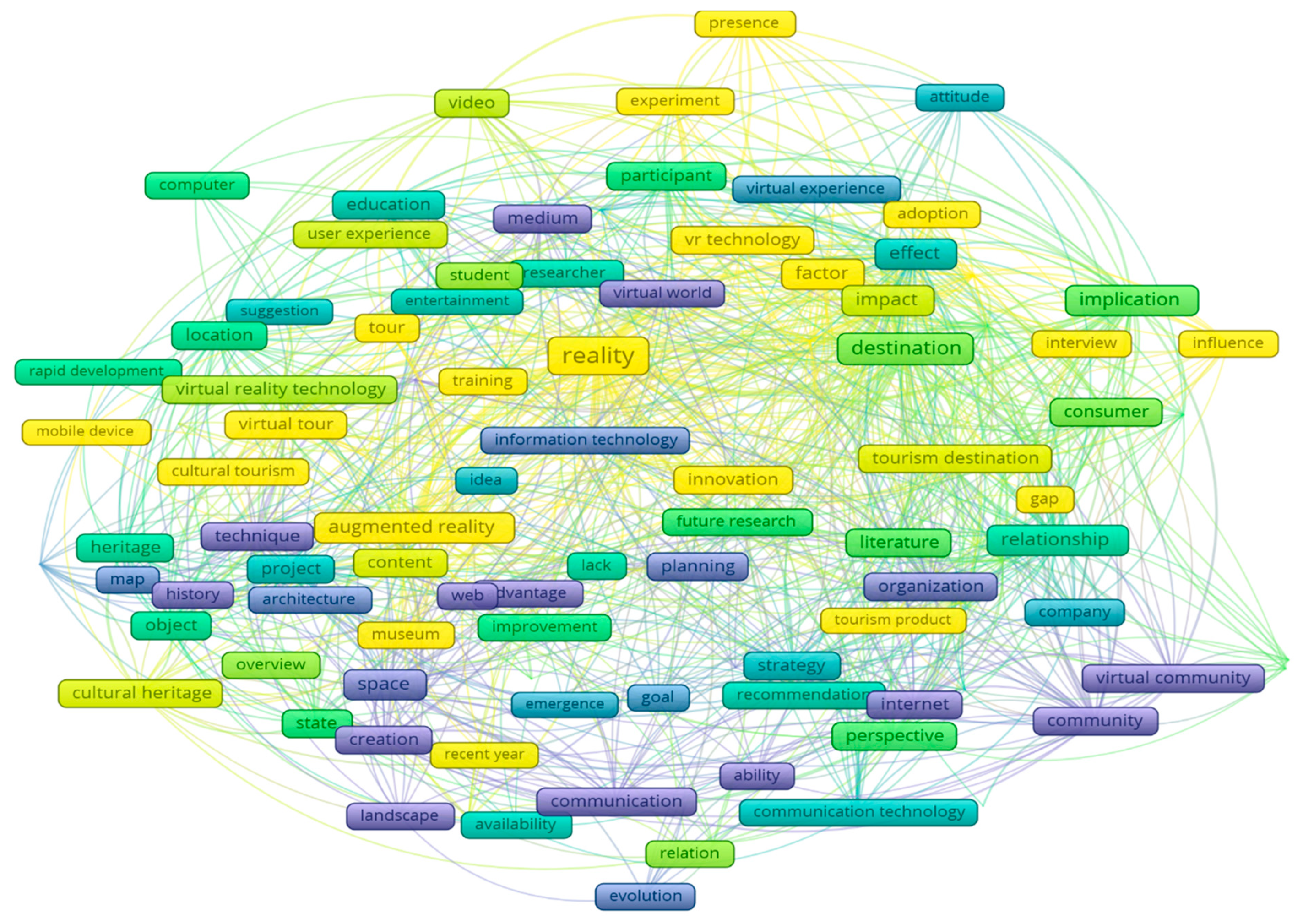
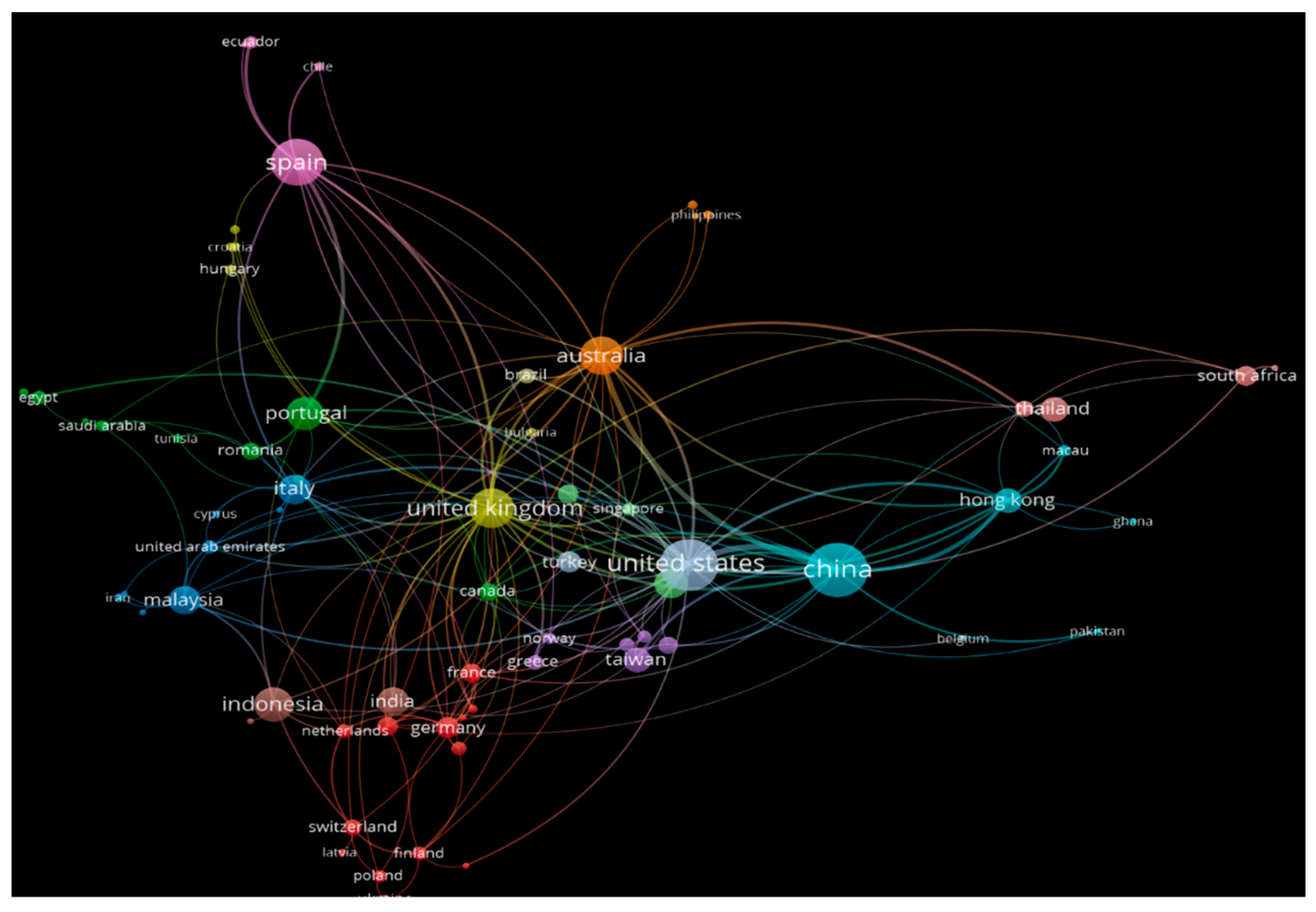
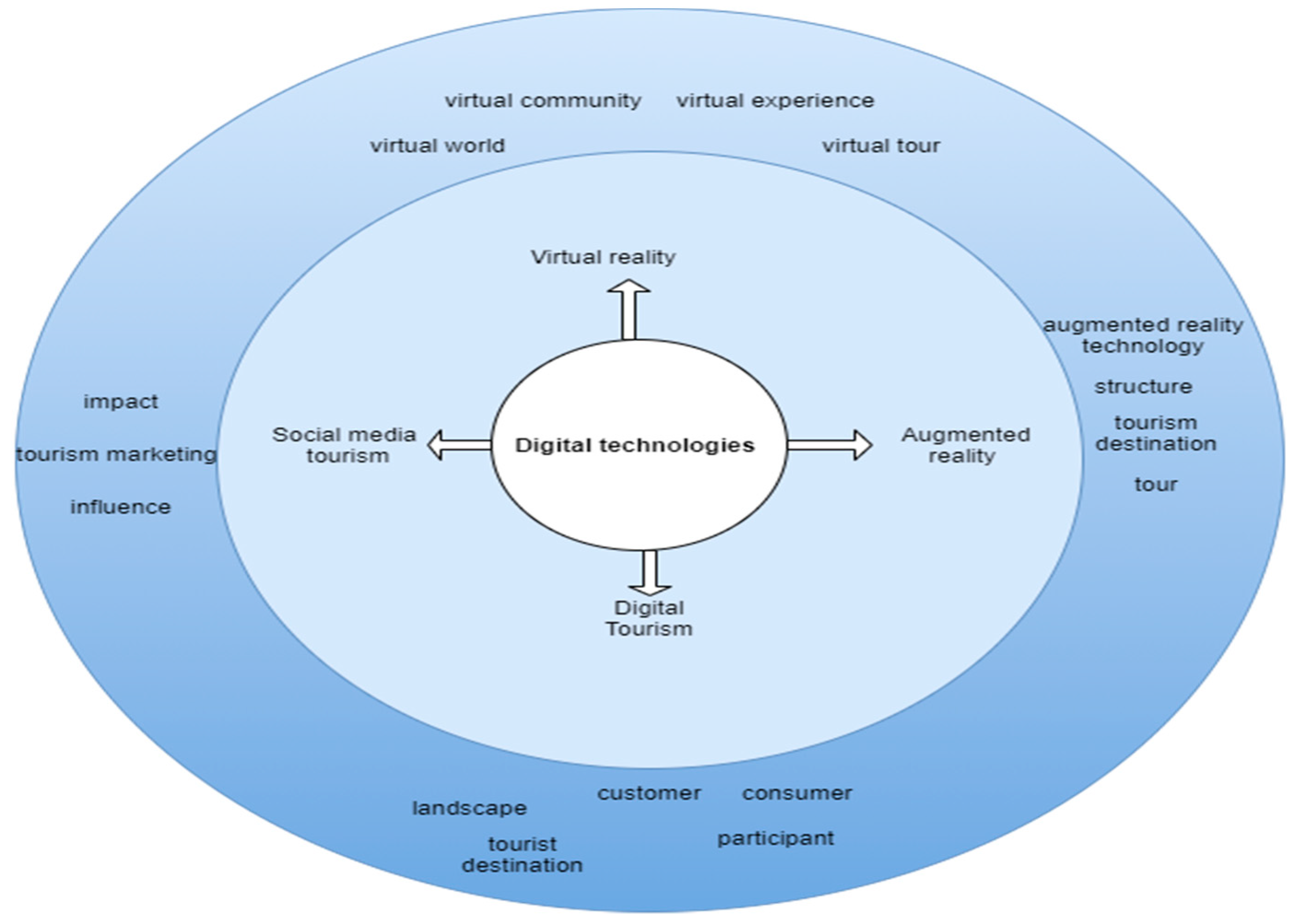
| Term | Occurrences | Relevance Score | Cluster Affiliation |
|---|---|---|---|
| Accessibility | 11 | 0.5601 | Digital tourism |
| Adoption | 18 | 0.8411 | Digital technologies |
| Architecture | 22 | 1.2726 | Digital tourism |
| Attitude | 17 | 1.1721 | Digital tourism |
| Augmented reality | 48 | 0.6103 | Augmented reality |
| Augmented reality technology | 13 | 1.1876 | Augmented reality |
| Behavior | 25 | 0.7555 | Digital tourism |
| Combination | 13 | 0.8864 | Digital technologies |
| Communication | 28 | 0.6362 | Digital technologies |
| Communication technology | 22 | 1.301 | Digital technologies |
| Community | 37 | 1.7189 | Digital tourism |
| Company | 20 | 1.088 | Digital technologies |
| Computer | 14 | 1.5764 | Digital technologies |
| Consumer | 29 | 0.9394 | Digital tourism |
| Content | 35 | 0.5187 | Digital technologies |
| Creation | 33 | 0.7548 | Digital technologies |
| Cultural heritage | 25 | 2.0259 | Virtual reality |
| Cultural tourism | 14 | 0.9845 | Virtual reality |
| Customer | 18 | 0.794 | Digital tourism |
| Destination | 64 | 0.3845 | Virtual reality |
| Education | 26 | 0.6654 | Virtual reality |
| Effect | 41 | 0.4718 | Virtual reality |
| Emergence | 12 | 0.7442 | Digital technologies |
| Entertainment | 11 | 0.8032 | Virtual reality |
| Evolution | 17 | 1.3053 | Social media |
| Experiment | 22 | 0.9922 | Social media |
| Future research | 15 | 0.2935 | Virtual reality |
| Game | 17 | 0.9626 | Virtual reality |
| Gap | 15 | 0.7606 | Virtual reality |
| Goal | 21 | 0.8351 | Digital tourism |
| Heritage | 25 | 1.6621 | Virtual reality |
| History | 18 | 1.8859 | Digital tourism |
| Ict | 14 | 1.0893 | Digital technologies |
| Idea | 21 | 0.4854 | Social media |
| Impact | 53 | 0.3791 | Social media |
| Implication | 42 | 1.3608 | Digital technologies |
| Influence | 21 | 1.1736 | Social media |
| Information technology | 24 | 0.4153 | Virtual reality |
| Innovation | 29 | 0.3825 | Virtual reality |
| Internet | 35 | 0.7206 | Digital technologies |
| Interview | 22 | 1.2014 | Digital technologies |
| Landscape | 18 | 1.226 | Digital tourism |
| Location | 29 | 1.1448 | Social media |
| Marketing | 31 | 0.6573 | Social media |
| Medium | 27 | 0.5263 | Social media |
| Mobile device | 12 | 2.0977 | Digital technologies |
| Museum | 21 | 1.0723 | Digital tourism |
| New technology | 14 | 0.5103 | Virtual reality |
| Organization | 34 | 0.5591 | Digital tourism |
| Overview | 15 | 1.8398 | Digital technologies |
| Participant | 30 | 0.516 | Digital tourism |
| Planning | 27 | 0.6501 | Digital technologies |
| Project | 38 | 0.857 | Augmented reality |
| Rapid development | 10 | 2.5559 | Digital technologies |
| Relationship | 43 | 0.8375 | Augmented reality |
| Researcher | 18 | 0.4483 | Digital technologies |
| Social medium | 11 | 2.3991 | Augmented reality |
| Space | 39 | 0.5775 | Augmented reality |
| State | 29 | 1.0498 | Augmented reality |
| Strategy | 35 | 0.5498 | Augmented reality |
| Structure | 20 | 0.7301 | Augmented reality |
| Tour | 32 | 0.8759 | Augmented reality |
| Tourism destination | 26 | 0.5615 | Augmented reality |
| Tourism experience | 19 | 0.5008 | Virtual reality |
| Tourism marketing | 15 | 0.4398 | Social media |
| Tourism product | 12 | 0.6677 | Virtual reality |
| Tourism sector | 27 | 0.7302 | Virtual reality |
| Tourist attraction | 14 | 1.9486 | Digital tourism |
| Tourist destination | 17 | 1.2581 | Digital tourism |
| Training | 17 | 0.7982 | Digital technologies |
| Traveler | 14 | 0.4503 | Digital technologies |
| User experience | 14 | 0.9117 | Virtual reality |
| Video | 32 | 1.1073 | Virtual reality |
| Virtual community | 30 | 2.4001 | Virtual reality |
| Virtual experience | 15 | 0.7811 | Virtual reality |
| Virtual reality technology | 36 | 0.9235 | Virtual reality |
| Virtual tour | 31 | 0.7862 | Virtual reality |
| Virtual world | 20 | 0.7232 | Virtual reality |
| Visualization | 20 | 2.9095 | Augmented reality |
| Vr technology | 30 | 0.5182 | Virtual reality |
| Web | 20 | 0.6348 | Virtual reality |
| Website | 15 | 1.0747 | Virtual reality |
| Authors | Methodology | Procedures | Settings | Findings |
|---|---|---|---|---|
| Qureshi et al. (2020) [15] | Quantitative | marketing practices | tourists’ destinations | This research provides valuable insights into how this new technology might function as a tool for marketing Jinan, a tier-two but historically significant destination in China. |
| Bogicevic et al. (2019) [18] | Quantitative | destination marketing | lab-coordinated experiment | Findings suggest that VR is substantial in prompting tourists to “daydream” about lodging offers before experiencing them at the destination’s premises. |
| Tussyadiah et al. (2018) [19] | quantitative | visitation intention | empirical | Therefore, this study provides empirical evidence to confirm VR’s effectiveness in shaping consumers’ attitudes and behavior. |
| Rejón-Guardia et al. (2020) [20] | theoretical framework | visit intention. | tourists’ destinations | The results demonstrated that the intention to visit places shown in VR tourism was influenced by attachment to VR. Cognitive response had a more substantial influence than the affective response to visiting a VR. This study sheds light on why potential tourists visit destinations shown in VR. |
| Errichiello et al. (2019) [20] | Quantitative | cultural tourism | museum visitors | |
| Kim & Hall, (2019) [21] | Quantitative | consumers | travel activities and behaviors | The findings offer new knowledge to researchers and industry in the VR tourism fields. |
| Han & Dieck, (2019) [23] | Quantitative | consumers | hospitality and tourism industry | To achieve this, the authors recommend using design methodology to focus on the first steps in the design process to identify and understand customers’ needs and desires independent of VR technology. |
| Jude Chigozie, (2020) [24] | secondary data | consumers | tourism planning and promotion | the study serves as a pointer to policymakers and academia of the vicissitudes of VR application in developing nations, with attendant value to neighboring countries and nations with interest in tourism due to the unpredictable future of VR, which keeps evolving daily |
| Authors | Methodology | Procedures | Settings | Findings |
|---|---|---|---|---|
| Orru et al. (2019) [29] | qualitative | responsible tourism | tourist destinations | Other stakeholders could use new emerging technologies, such as virtual reality, to offer tourists the opportunity to experience tourism products and places before traveling. |
| Schott & Marshall, (2018) [32] | qualitative | virtual environment | experiential education | The results demonstrate that complex immersive learning environments are readily achievable but that high levels of interactivity remain a challenge |
| Moorhouse, (2019) [26] | qualitative | destination marketing | explanatory | Finally, theoretical contributions, practical implications, and avenues for further research are provided. |
| Buhalis et al. (2019) [33] | qualitative | consumers | events | Uses and Gratifications (UG) Theory |
| (Marasco & Balbi, (2019) [30] | qualitative | visitors’ perspective | heritage destinations | Through multimethod explorative research, personas and scenarios are developed to inform the subsequent co-design of virtual reality solutions along the visitors’ journey |
| Louw & Louw, (2018) [28] | Quantitative | Pro-ecological beliefs | tourism research | As VT is better received among women, lower educated people, and 50–70-year-olds, these may be ideal target groups for the promotion of mediated nature experiences |
| Authors | Methodology | Procedures | Settings | Findings |
|---|---|---|---|---|
| Keckes & Tomicic, (2017) [35] | qualitative | cultural tourism | visitor adoption | Findings inform an ARSG adoption framework that integrates societal impact, perceived benefits, perceived attributes of innovation, and visitor resistance as the main themes of ARSG adoption in cultural tourism |
| Barrado-Timón & Hidalgo-Giralt, (2019) [36] | Reality | the urban environment in tourism | digital development | New perspective directions are proposed to improve the institutional environment and sustainable positive dynamics of social rehabilitation, reduce social tensions, and fill free time for recipients of tourist services. The vectors of territories’ digital development are determined. |
| He et al. (2018) [37] | qualitative | museum tourism | experimental | Using an experimental approach, the results demonstrate that compared with dynamic visual cues. Dynamic verbal cues lead to visitors’ higher levels of willingness to pay more. Such an effect is more salient when environmental augmentation provides a high level of virtual presence. The psychological mechanism of mental imagery can explain such effects. |
| Gibson & O’Rawe, (2018) [38] | qualitative | urban heritage spaces | tourists | Our main conclusion is that concerns around the critical aspects are minimal, with only a few perceiving the possible dangers of trivialization of heritage, the creation of virtual tourist worlds separate from the material space of socio-economic relations, adverse effects on how knowledge is constructed, or the difficulties for some user groups in accessing these technologies. |
| Coghlan & Carter (2020) [39] | Quantitative | advertising effectiveness | websites | Visual attention to the ad banner was paid at a low level of awareness, explaining why the ad’s associations did not activate its subsequent recall. |
Publisher’s Note: MDPI stays neutral with regard to jurisdictional claims in published maps and institutional affiliations. |
© 2021 by the authors. Licensee MDPI, Basel, Switzerland. This article is an open access article distributed under the terms and conditions of the Creative Commons Attribution (CC BY) license (https://creativecommons.org/licenses/by/4.0/).
Share and Cite
Akhtar, N.; Khan, N.; Mahroof Khan, M.; Ashraf, S.; Hashmi, M.S.; Khan, M.M.; Hishan, S.S. Post-COVID 19 Tourism: Will Digital Tourism Replace Mass Tourism? Sustainability 2021, 13, 5352. https://doi.org/10.3390/su13105352
Akhtar N, Khan N, Mahroof Khan M, Ashraf S, Hashmi MS, Khan MM, Hishan SS. Post-COVID 19 Tourism: Will Digital Tourism Replace Mass Tourism? Sustainability. 2021; 13(10):5352. https://doi.org/10.3390/su13105352
Chicago/Turabian StyleAkhtar, Nadeem, Nohman Khan, Muhammad Mahroof Khan, Shagufta Ashraf, Muhammad Saim Hashmi, Muhammad Muddassar Khan, and Sanil S. Hishan. 2021. "Post-COVID 19 Tourism: Will Digital Tourism Replace Mass Tourism?" Sustainability 13, no. 10: 5352. https://doi.org/10.3390/su13105352
APA StyleAkhtar, N., Khan, N., Mahroof Khan, M., Ashraf, S., Hashmi, M. S., Khan, M. M., & Hishan, S. S. (2021). Post-COVID 19 Tourism: Will Digital Tourism Replace Mass Tourism? Sustainability, 13(10), 5352. https://doi.org/10.3390/su13105352







